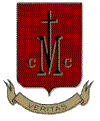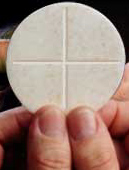 |

|
Eucharist: A Pure, White, Round, Spotless Host
 Some
prelates of the American Catholic hierarchy have emphasized the need
for Eucharistic “bread that is bread or appears to be bread to
all the senses” in their call for liturgical reform. They broaden
this to be more specifically, like actual table food. Interestingly,
certain paraliturgical groups have even used conventional household
loaf bread in their liturgical ceremonies. Of course, in truly Latin
Rite Catholic liturgy, we are required by the rubrics to use unleavened
bread from approved recipes consistent with Christ’s Passover
meal. What might the Lord Jesus expect from us in this regard? There
is no gospel passage about it, but there are the insights we can receive
from the mystics. Certainly, some priests and laity are skeptical of
the information that can be gleaned from private revelation. Father
Groeschel in his book, A Still, Small Voice, discusses this point.
Some
prelates of the American Catholic hierarchy have emphasized the need
for Eucharistic “bread that is bread or appears to be bread to
all the senses” in their call for liturgical reform. They broaden
this to be more specifically, like actual table food. Interestingly,
certain paraliturgical groups have even used conventional household
loaf bread in their liturgical ceremonies. Of course, in truly Latin
Rite Catholic liturgy, we are required by the rubrics to use unleavened
bread from approved recipes consistent with Christ’s Passover
meal. What might the Lord Jesus expect from us in this regard? There
is no gospel passage about it, but there are the insights we can receive
from the mystics. Certainly, some priests and laity are skeptical of
the information that can be gleaned from private revelation. Father
Groeschel in his book, A Still, Small Voice, discusses this point.
Although some may have healthy skepticism regarding private revelations, one can obtain certain insights by contemplating their contents. While private revelation can not add to divine revelation, it can color, enrich and enhance our understanding and perception of it, especially in its emotional content. Early church members used bread that was more like household loaf bread. Perhaps its early members realized that a more reverent symbol was required or that crumbling and fragmentation of the bread caused the Body of Christ to be inadvertently lost or desecrated. In realizing this bread was the Body, Blood, Soul and Divinity of Christ they appear to have devised a way of giving us unleavened breads that would be more confined and pure. A more complete theology of the Eucharist developed over centuries from Tradition and the Magisterium of the Church, by the guidance of the Holy Spirit. This theology suggests that spiritual food doesn’t always have to look like our idea of conventional food, though it shouldn’t look like plastic or taste like grass.
What do some mystics say that Our Lord pronounces about the appearances of the Eucharist? In a pamphlet entitled, “I Wait for You”, from The Way of Divine Life, by Sister Josefa Menendez (1890-1923), we have specific descriptions that she attributes to Jesus. He describes Himself to her as being “Heavenly Food.” That suggests perhaps something that might not truly resemble earthly food or conventional household bread. He later says, “Indeed, O consecrated souls, you will find a perfect symbol of your vow of Poverty in the small, round, light and smooth host: for so must the soul that professed poverty be: no angles, that is to say, no petty natural affections….” He then says, “Tell them how they will find in the small white Host a perfect symbol of the vow of Chastity….” We may also perceive the consecrated host in another manner. As pure white light reflects off the bread of life, it contains all color frequencies, reminding us that Christ said, “I am the light of the world (Jn 8:12).” This light “shines in the darkness and the darkness has not overcome it (Jn 1:5).” He represents everything to us and reflects all of us contained in the Body of Christ. Thus through the Eucharist, we become “the light of the world” (Mt 5:14) as Christ shines through us.
There have been many other Eucharistic Miracles that portray the Eucharist as a small, white, round, and spotless host. Some of these hosts have miraculously appeared on the tongue of the beholder. Eucharistic miracles depict this bread or host as the Lord’s flesh rather then real bread or food. Occasionally in miracles, the host actually becomes flesh or blood in unique circumstances.
Sometimes in our eagerness to make ourselves feel good, we desire to see things that are not willed by God, in this case, His Son in the appearance of His glorified flesh, seemingly revealed in Sister Menedez’ private revelation. Perhaps instead, we should yearn to see in the unblemished host of the Latin Rite, the purity and perfection to which each of us should aspire. This Eucharistic Host may represent the faultlessness, innocence and simplicity of the unexpected infant Jesus. It is the spiritual uniformity of the diverse Body of Christ. Further, it resembles or symbolizes His poverty, a seeming dearth of substance so easily consumed. Ultimately the host represents His infinity, traversing along its circular boundary in an unending pursuit of souls. Like Thompson’s “Hound of Heaven,” Christ seeks us out at every Mass through His Word and Eucharist. Reception of communion should be a mystical experience far removed from the gastronomic indulgence in a restaurant. It should have a worthy and reverent visible sign.
Nicholas E. Barreca,
M.D.
Feast of Corpus Christi
June 1997
Endnotes
1 The current GIRM (Paragraph 320-321; copyright 2002) says that “bread for celebrating the Eucharist must be made only from wheat…recently baked,…according to the ancient tradition of the Latin Church, must be unleavened” and “truly have the appearance of food.” Some of these requirements are also covered in the 1983 Code of Cannon Law (924.2 & 926).
2 “Gather Faithfully Together” by Cardinal Roger Mahoney, Archbishop of Los Angeles, two documents of the same name, September 4, 1997 and November 3, 1998.
3 Call to Action meetings.
4 Eastern Rite Catholics use leavened bread in the form of cubes (often received in both kinds using a spoon), except among the Maronites, the Armenians, and in the Churches of Jerusalem and Alexandria, where it is unleavened. Either kind of bread is valid matter for the sacrament. However, Paul says, “Let us therefore, celebrate the festival, not with the old leaven, the leaven of malice and evil, but with the unleavened bread of sincerity and truth” 1 Cor 5:8). Perhaps this article should be pause for the reassessment of the Eastern Tradition.
5 “Although in the beginning bread which served for common [household] use was offered at the altar, still growing reverence for Holy Eucharist soon effected a change, so that the altar-breads were specially prepared, assigning a round form of moderate thickness, and were stamped with a cross or some other significant religious emblem having special reference to Our Lord in the Eucharist. These hosts became smaller and thinner in the Western Church until they assumed the light, wafer-like form now so common.” Quoted from the on-line New Advent Catholic Encyclopedia, “Liturgical Use of Bread.”